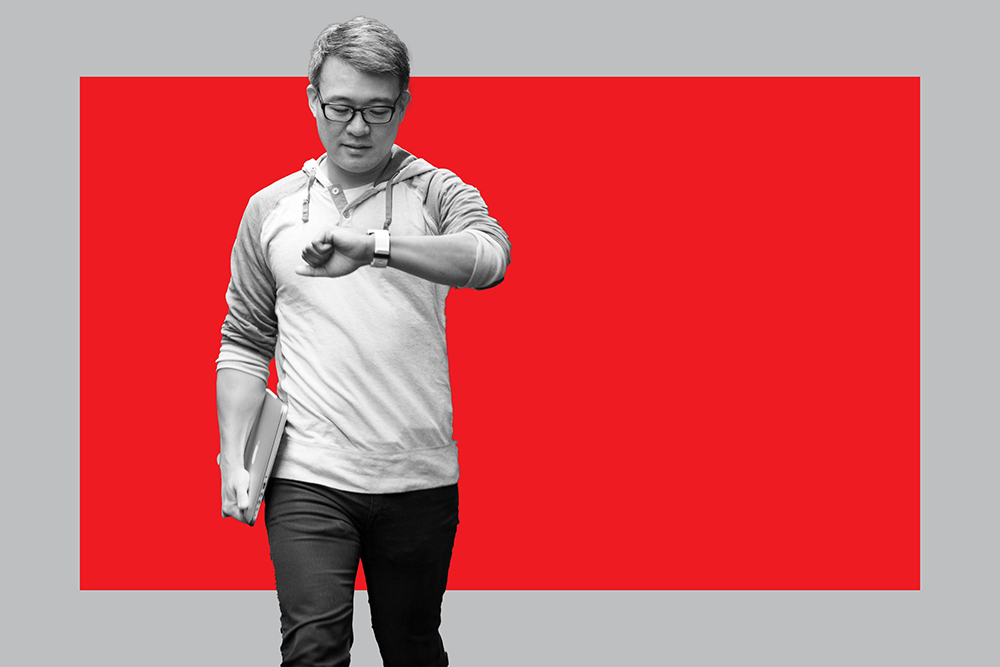硅谷CEO告诉你,为什么每天要走1万步

“日行一万步的目标”起源于1965年,当时一家日本计步器制造商发明了一种名为Manpo-kei的计步仪器,用中文翻译过来就是“万步计”。40多年后,Fitbit在2009年年底向消费者推出了第一款可穿戴计步设备,并将这一“目标”推向全球。我和我的联合创始人埃里克·弗里德曼对这一设计的灵感,来源于传感技术在健身游戏方面的可期前景。比如任天堂Wii游戏机上的传感器技术,让健康变得有趣并触手可及。
最近,“日行一万步的目标”遭到了一些评论家的质疑,他们认为这一目标过于简单,或是过于激进。不过我相信,在全球范围内,人们还是会把这视为一个可以激励自己走得更多的重要目标。但同样重要的是,这一目标可能仅仅适用于那些想要改善自身健康的人。这也就是为什么Fitbit和其他可穿戴设备公司的产品都在不断地更新迭代,以追踪关于健康的其他指标,将这些指标进行有机结合,并为实现健康目标提供指导。
一万步的目标还符合美国疾病控制和预防中心的建议,即每周至少进行150分钟的适度运动(或每天锻炼30分钟)。一天走一万步加起来大约为5英里,所以我们觉得对大多数人来说这是个很好的开始。我们的宗旨一直都是:你可以根据自己的需求进行个性化设置,每天想怎么设置就怎么设置。
研究表明,增加运动量与改善健康息息相关,包括预防疾病、改善认知功能和提升睡眠质量。虽然绝大部分人都明白这一点,但在起步阶段可能还是会让人不知所措。我们发现了一种可以让用户更积极地使用这款设备的方式,那就是让你在使用设备时有参与感以并能与他人互动,比如每完成一个小里程碑都会为你授予庆祝徽章,以及你可以与朋友和家人制定挑战、共同竞赛。
我记得有一次在机场,我看到一些人在谈论他们是否达到了他们的步数目标,然后不约而同地在快接近午夜的时候四处走动,从而完成一万步的目标。他们因此被激励,更重要的是,他们是共同完成的。从那时起,我就知道使用我们的这款设备俨然成为了当下流行。
虽然一万步目标在我们的健身文化中已经根深蒂固,但健康的意义远不止于此。随着科技的发展,我们和其他可穿戴设备制造商也在不断进步。
我们决定下一步解决睡眠问题,因为我们都知道,睡眠对整体的健康至关重要。研究表明,睡眠不足不但会影响我们的认知功能,还会导致我们罹患慢性疾病的风险增加,比如心脏病和糖尿病。除了参观昂贵的睡眠实验室之外,目前仍然没有一种简单的方法可以追踪或理解我们的睡眠。虽然我们经常被告知每晚要睡足8小时,但这个数字只是方程式的一部分。同样重要的是,我们要有一个私人定制的睡眠时间表,来帮助我们获得足够的快速眼动和深度睡眠,并确保我们睡眠时的静息心率低于白天的心率,从而能够帮助我们恢复体力以避免第二天有一种“宿醉”感。
随着时间的推移,精密的传感器和先进的算法技术,首次帮助我们将更多的健康指标引入手环,比如心率跟踪。这一突破很重要,因为心率影响着身体的诸多功能,而心律跟踪可以让用户对身体有更深入的了解,比如静息心率、睡眠质量、血氧评估。还有“Active Zone Minutes”这一全新健身指标功能,它能够帮助用户判断自己是否达到了进行更高强度锻炼的目标。自从推出了心率跟踪系统,我们从全球用户那里听到了无数关于他们的Fitbit拯救了他们的生命故事。因此,我们目前正在进行一项研究,以验证Fitbit技术在识别心房颤动(或不规则心率)方面的应用,该研究还将继续改革,使可穿戴设备真正成为健康的“检查引擎”。
不过,你不能只谈健康问题而不提及压力,尤其是当下,一场前所未有的全球性疫情正严重影着我们的生活和工作。研究表明,运动与心理健康之间存在联系,即运动可以帮助我们改善情绪、缓解压力。只要一次正念训练就能帮助你体会到运动对心理和生理上的益处。人们可以通过各种方式进行正念训练,而可穿戴设备支持大部分的训练——利用正念应用程序帮助你冥想和呼吸引导。而这只是对未来的一种尝试。
我们已经走了很长的路,但又感觉才刚刚开始。步骤永远是方程式的一部分,而我们可以做得更多。我们致力于打破阻碍人们变健康的障碍,让世界上每个人都变得更加健康。可穿戴设备已经成为我们生活中必不可少的一部分,从帮助用户增加运动量、改善睡眠状况,到早期疾病的发现……这让我深受鼓舞。可穿戴设备帮助我们改善身体健康的潜力是无限的。如果你想知道的话,请参考我的Fitbit——我走了接近3500万步,平均每天一万步。(财富中文网)
詹姆斯·帕克是Fitbit公司的联合创始人及首席执行官。
编译:刘心辰
“日行一万步的目标”起源于1965年,当时一家日本计步器制造商发明了一种名为Manpo-kei的计步仪器,用中文翻译过来就是“万步计”。40多年后,Fitbit在2009年年底向消费者推出了第一款可穿戴计步设备,并将这一“目标”推向全球。我和我的联合创始人埃里克·弗里德曼对这一设计的灵感,来源于传感技术在健身游戏方面的可期前景。比如任天堂Wii游戏机上的传感器技术,让健康变得有趣并触手可及。
最近,“日行一万步的目标”遭到了一些评论家的质疑,他们认为这一目标过于简单,或是过于激进。不过我相信,在全球范围内,人们还是会把这视为一个可以激励自己走得更多的重要目标。但同样重要的是,这一目标可能仅仅适用于那些想要改善自身健康的人。这也就是为什么Fitbit和其他可穿戴设备公司的产品都在不断地更新迭代,以追踪关于健康的其他指标,将这些指标进行有机结合,并为实现健康目标提供指导。
一万步的目标还符合美国疾病控制和预防中心的建议,即每周至少进行150分钟的适度运动(或每天锻炼30分钟)。一天走一万步加起来大约为5英里,所以我们觉得对大多数人来说这是个很好的开始。我们的宗旨一直都是:你可以根据自己的需求进行个性化设置,每天想怎么设置就怎么设置。
研究表明,增加运动量与改善健康息息相关,包括预防疾病、改善认知功能和提升睡眠质量。虽然绝大部分人都明白这一点,但在起步阶段可能还是会让人不知所措。我们发现了一种可以让用户更积极地使用这款设备的方式,那就是让你在使用设备时有参与感以并能与他人互动,比如每完成一个小里程碑都会为你授予庆祝徽章,以及你可以与朋友和家人制定挑战、共同竞赛。
我记得有一次在机场,我看到一些人在谈论他们是否达到了他们的步数目标,然后不约而同地在快接近午夜的时候四处走动,从而完成一万步的目标。他们因此被激励,更重要的是,他们是共同完成的。从那时起,我就知道使用我们的这款设备俨然成为了当下流行。
虽然一万步目标在我们的健身文化中已经根深蒂固,但健康的意义远不止于此。随着科技的发展,我们和其他可穿戴设备制造商也在不断进步。
我们决定下一步解决睡眠问题,因为我们都知道,睡眠对整体的健康至关重要。研究表明,睡眠不足不但会影响我们的认知功能,还会导致我们罹患慢性疾病的风险增加,比如心脏病和糖尿病。除了参观昂贵的睡眠实验室之外,目前仍然没有一种简单的方法可以追踪或理解我们的睡眠。虽然我们经常被告知每晚要睡足8小时,但这个数字只是方程式的一部分。同样重要的是,我们要有一个私人定制的睡眠时间表,来帮助我们获得足够的快速眼动和深度睡眠,并确保我们睡眠时的静息心率低于白天的心率,从而能够帮助我们恢复体力以避免第二天有一种“宿醉”感。
随着时间的推移,精密的传感器和先进的算法技术,首次帮助我们将更多的健康指标引入手环,比如心率跟踪。这一突破很重要,因为心率影响着身体的诸多功能,而心律跟踪可以让用户对身体有更深入的了解,比如静息心率、睡眠质量、血氧评估。还有“Active Zone Minutes”这一全新健身指标功能,它能够帮助用户判断自己是否达到了进行更高强度锻炼的目标。自从推出了心率跟踪系统,我们从全球用户那里听到了无数关于他们的Fitbit拯救了他们的生命故事。因此,我们目前正在进行一项研究,以验证Fitbit技术在识别心房颤动(或不规则心率)方面的应用,该研究还将继续改革,使可穿戴设备真正成为健康的“检查引擎”。
不过,你不能只谈健康问题而不提及压力,尤其是当下,一场前所未有的全球性疫情正严重影着我们的生活和工作。研究表明,运动与心理健康之间存在联系,即运动可以帮助我们改善情绪、缓解压力。只要一次正念训练就能帮助你体会到运动对心理和生理上的益处。人们可以通过各种方式进行正念训练,而可穿戴设备支持大部分的训练——利用正念应用程序帮助你冥想和呼吸引导。而这只是对未来的一种尝试。
我们已经走了很长的路,但又感觉才刚刚开始。步骤永远是方程式的一部分,而我们可以做得更多。我们致力于打破阻碍人们变健康的障碍,让世界上每个人都变得更加健康。可穿戴设备已经成为我们生活中必不可少的一部分,从帮助用户增加运动量、改善睡眠状况,到早期疾病的发现……这让我深受鼓舞。可穿戴设备帮助我们改善身体健康的潜力是无限的。如果你想知道的话,请参考我的Fitbit——我走了接近3500万步,平均每天一万步。(财富中文网)
詹姆斯·帕克是Fitbit公司的联合创始人及首席执行官。
编译:刘心辰
The goal of walking 10,000 steps a day originated in 1965 when a Japanese pedometer manufacturer created a device called Manpo-kei, which translates to “10,000-steps meter.” More than 40 years later, Fitbit put this goal on the map globally with the launch of our first wearable at the end of 2009. My cofounder, Eric Friedman, and I were inspired by the prospect of using sensor technology, like that on a Nintendo Wii, to gamify fitness and make getting healthy fun and achievable.
Recently, the 10,000-steps-a-day goal has encountered some skepticism from commentators who view it as too simplistic (or too ambitious). I believe people around the world still see it as a valuable target that motivates them to move more. But it’s also important to remember that this is just one of many benchmarks for those seeking better health. That’s why it’s so important that Fitbit and other wearable companies continue to evolve to track other areas of your health, show how they all fit together, and provide guidance on how to achieve these goals.
The 10,000-step goal satisfies the Centers for Disease Control and Prevention’s recommendation of at least 150 minutes of moderate exercise per week (or 30 minutes of daily exercise). Ten thousand steps add up to about five miles a day, so we felt it was a good place to start for most people. The goal was always meant to be something you could personalize for your needs, which can shift over time.
Research shows increased activity is linked to health improvements, including disease prevention, improved cognitive function, and better sleep. While many of us understand the benefits, getting started can be overwhelming. We saw an opportunity to make getting active easier by making it engaging and social, awarding celebratory badges for step milestones, and creating challenges to compete with friends and family.
I remember sitting in an airport, when some people started talking about whether they’d hit their step goal, and then began walking around at nearly midnight to reach 10,000 steps. They were motivated, and importantly, doing it together. That’s when I knew what we created had become a phenomenon.
While the 10,000-step goal remains ingrained in our fitness culture, there is more to health than steps. As technology evolved, so did we and other wearables makers.
We decided to tackle sleep next because we knew it was critical to overall health, with research showing that poor sleep impacts cognitive function and can lead to increased risk of chronic diseases, including heart disease and diabetes. And there still wasn’t an easy way to track sleep or understand it outside of visiting an expensive sleep lab. While we’re often told to get eight hours of sleep a night, the number is only part of the equation. It’s also important to have a consistent sleep schedule to avoid feeling “hungover” the next day, to get enough REM and deep sleep to aid in recovery, and to ensure your resting heart rate is below your daytime heart rate for maximum restoration. Today, we can provide insight into all of this with wearables.
Over time, sophisticated sensors and advanced algorithms made it possible to introduce more health metrics to the wrist for the first time—like heart-rate tracking. This breakthrough was important because heart rate powers many features that give users deeper insights, including resting heart rate (an indicator of overall heart health), sleep quality, estimated oxygen variation, and Active Zone Minutes, a new metric that helps users tell whether they’re meeting goals for more vigorous exercise. Since launching heart-rate tracking, we’ve heard countless stories from global users that their Fitbit saved their life. As such, we currently have a study in progress to validate the use of Fitbit’s technology to identify atrial fibrillation (or irregular heart rate), and the plan is to continue innovating so wearables truly can be a “check engine” light for health.
You can’t address health without talking about stress, especially now, when an unprecedented global pandemic has significantly impacted the way we live and work. Research has established a link between exercise and mental health, demonstrating that it can lift mood and relieve stress. As little as one mindfulness session can help you experience psychological and physiological benefits. People can practice mindfulness in various ways—many of which are supported by wearables, from meditations and guided breathing to mindfulness apps. And this is just a taste of what’s ahead.
We’ve come a long way, but it feels like we’re just getting started. Steps will always be part of the equation, but we can do more. We’re committed to breaking down barriers that prevent people from achieving better health so everyone in the world can be healthier. I’m inspired by how wearables have become an essential part of our lives, from increasing activity to sleeping better, to early illness detection. The potential for wearables to improve our health is unlimited. And in case you’re wondering, my lifetime steps on Fitbit are nearly 35 million-—or, on average, 10,000 steps a day.
James Park is the cofounder and CEO of Fitbit.













